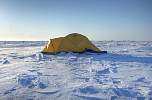
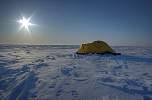
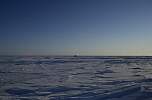

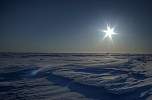
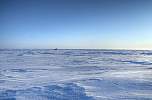
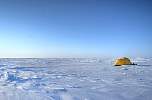
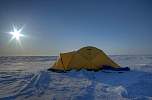
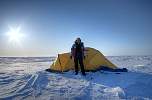
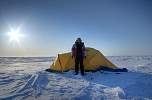
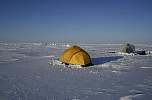
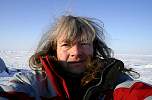


After a couple of hours of sleep, it was time to do the 'serious' North Pole tourist stuff:
Taking pictures.
So here we are: Me, the tent and the North Pole.
An odd name for a tent. It probably means comfort...
Undoubtedly a room with a view. And a spectacular one as well.
Later that morning, I went over to Eric, Heinz and Lyndy's tent for breakfast.
(I didn't intent to do that, but I had a bit of a mishap with the cooker when I tried to make some morning coffee. Nothing serious happened, but I wasn't really keen to try to light it again.)
Luckily they had a fairly spacious tent. And it turned out to be another of these 'unexpected things'. You expect tents in Arctic regions to have double walls to provide some insulation. Eric's tent had an inner wall and an outer wall, but the inner part was just a mesh tent. Great to protect from mosquitoes, but utterly useless to keep the warmth in.
Odd, but sensible. There's not really that much insulation provided by the air trapped between two thin layers of cloth. The main issue is that the outer tent wall keeps the wind from blowing through the tent. And while you have the cooker running, it is warm and comfortable in any case and once you turn it off, the tent will be cold next morning, regardless of its construction. So it doesn't really matter whether you have a solid inner tent. But on a mesh, the won't be much moisture, so when you warm the tent up on the next morning, the inner tent will be mostly try and not wet and clammy. Neat.
I wanted to eat over my own 'surprise breakfast' from the Cyrillic labeled food pack, but it turned out to be dehydrated butter (I didn't even know that such a thing existed), which didn't quite make a full breakfast. (Especially since I had eaten the crispbread, for which it was probably intended, the previous evening.) Eric shared some of his own muesli.
Then it was time to go outside and do some 'At the North Pole' pictures with Eric's North Pole banner.
It was, admittedly quite silly, but since I had done it at the South Pole and the weather condition was similar, I also took some "Cold at the Pole? No way..." pictures.
It really doesn't feel as cold as it looks, but probably adrenaline has a lot to do with that.
The helicopter was supposed to pick us up at about 2pm, so around 1:30pm it was time to disassemble the tents and put everything pack on the sledges.
The only things remaining were the traces were the cooker and the cattle had been standing.
Then it was time to stand around, enjoy the scenery a bit longer and say good-bye to the North Pole, waiting for the helicopter to pick us up.
The helicopter turned up about an hour later than expected, but that wasn't a problem in that weather, and we just stood around. Quite content, but a bit aimlessly.
Then the helicopter arrived and we go aboard. With the four of us, the seven guys from PolarExplorers, the overnighter and his guide from VICAAR and two Czech guys, who had skiied the long way, we were fifteen people and, except for the overnighters, all with sledges, so the helicopter was quite crowded again.
I am not sure whether the lead I could see from the helicopter was the one that we had skied in on the previous day, but at least it looked similar.
After less than ten minutes flight, there was a bit of a surprise. The helicopter landed again and we were told 'everybody out'. We weren't quite sure why.
When we got out, the engines were shut down (which is unusual - standard procedure is to keep them running when being 'out there' and only switch them off back at base camp), the loading bay at the back of the helicopter was opened and we were told to get out sledges out of the helicopter.
It was a bit confusing, but the reason for this was about a hundred meters away.
We were picking up a small group on a dog sledding tour. There were two sledges there, with two persons (they had taken turns with driving) and six dogs for each sledge.
Since their sledges were a lot bigger and wider than ours, they were the first to go into the helicopter, before ours were piled on top of them. Then they closed the loading bay and opened a small hatch at the side of it and someone said "Twelve of you go over to the dogs and each walks one of them to the helicopter."
So we went over, grabbed a dog and went walkies (or, more accurately, tried not to fall over while the dogs pulled us to the helicopter). Then most of the dogs were taken and dropped through the hatch into the back end of the helicopter, where their handler took care of them.
The last three dogs went with all the people into the front part of the helicopter.
While the helicopter had already seemed crowded before, we now had an additional four people, two large sledges and a dozen dogs on board. People, dogs and gear in one big heap. Too bad I don't have any good picture of it, but there just wasn't enough room to step back and get a decent overview.
Dogs on a helicopter. Much more comforting than snakes on a plane.
I was very much surprised how stoic these dogs were. While it probably wasn't their first trip on a helicopter, they were in a noisy environment, packed tied with people they didn't know, but they just sat there with the slightly bored expression of someone taking the same crowded bus to work for a decade.
It was noticeable that the helicopter had been flying at 'normal' height (a hundred meter or so) before we picked up the dogs, but was flying very low (difficult to tell, but I'd guess between two and five meters) for the rest of the way. I'm not sure why. Heinz (who, as a pilot, had some knowledge in these matters) suggested that the helicopter was overloaded and the pilots were using the 'ground effect' to be able to fly at all. I former colleague of mine (who studied airplane construction) doubted that, since the MI-8 was designed as a transport helicopter and should be able to deal with such a load. (A rough calculation suggests that we were 19 persons on board and 12 dogs. Assuming 100 kg per person, 20 kg each for sledge and gear and 50 kg per dog, this ends up at 2880 kg load, which should be well within the capability of an MI-8.) But whatever the reason, we were flying low...
Back at Barneo Base someone had been working on the sign, so by now the 'e' was fairly recognizable.
Time for a short dinner before at was time to head back with the Antonov to Longyearbyen. (Usually we would have gone almost directly from the helicopter to the plane, but somehow the second helicopter crew had managed to forget to pick up a team out on the ice. With satellite phone communication, this wasn't a serious problem, the helicopter just went off again to collect them and they were back at Barneo two outs later, giving us time to grab something to eat.)
Late in the evening we were back in Svalbard and the trip was over. Arriving at Longyearbyen airport, it felt surprisingly warm. At first I put that down to the temperature difference between the Pole (-29°C, -20°F) and the temperature at Longyearbyen when I left (-15°C, 5°F), but it turned out that Longyearbyen really had some odd weather while I was away. Temperature had dropped sharply while I was at the Pole, with a snow storm added for inconvenience, but then had increased to +5°C by the time the plane had returned. A 20 degree temperature difference in three days and a full 34 degree warmer than the previous night at the Pole.
Next day there was a small "achievement ceremony" where we got certificates and a nice keepsake, but mostly it gave as a chance to exchange fresh memories and talk about our trips. It was especially interesting to talk to two Swiss women, who had been on the dog sledge trip and were still very excited by it and still being in a dog filled universe of their own.
Sounds like a fun thing to do. Maybe some day...
And with that, the trip was over. Time to say good-bye to the sledge.
And, to close the part about going to the pole, here's the track log and some associated data.
I didn't record the full route, since I only turned on the GPS during the rest stop. At the lower left, you can see the starting point of the trip (where the helicopter dropped us). We then moved quite a bit until we had a rest. From there, we followed the lead, so the route does not go directly to the North Pole. You can easily see where we left the lead and turned directly to the Pole.
After reaching the Pole, we moved a bit onwards and put up the tents. From 18:00, the GPS was just sitting in the tent and not moving. But, as you can see, it moves quite a bit due to the drifting of the ice. The GPS kept working until about 01:30, when the batteries gave in. I put in new batteries in the morning and took further positions around 07:00 and noon.
Just to give an idea of the drift: The difference between the position at 18:00 and the one at 12:38 the next day (the last reliable position I have recorded) was a bit more than 4 kilometers, giving a drift rate of about 5.25 kilometers per day.
And that's it about the "North Pole" part of the trip. But Arctic travel is never quite reliable (even though all the planned dates were actually kept), so I had a couple of 'buffer days' after the North Pole trip, just in case.
So it was time to book a couple of tours. More about these on the next page.